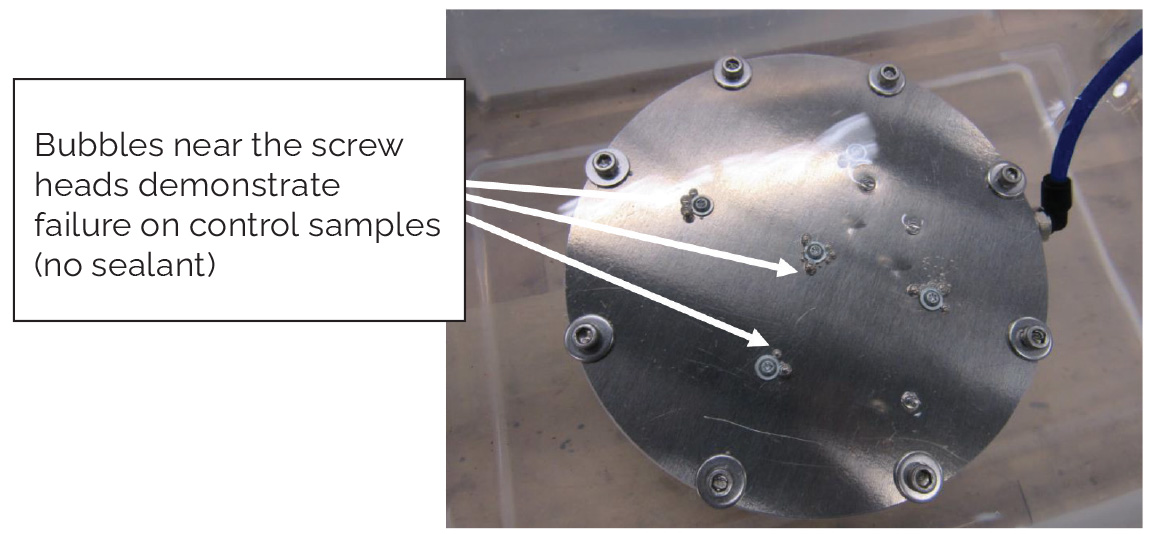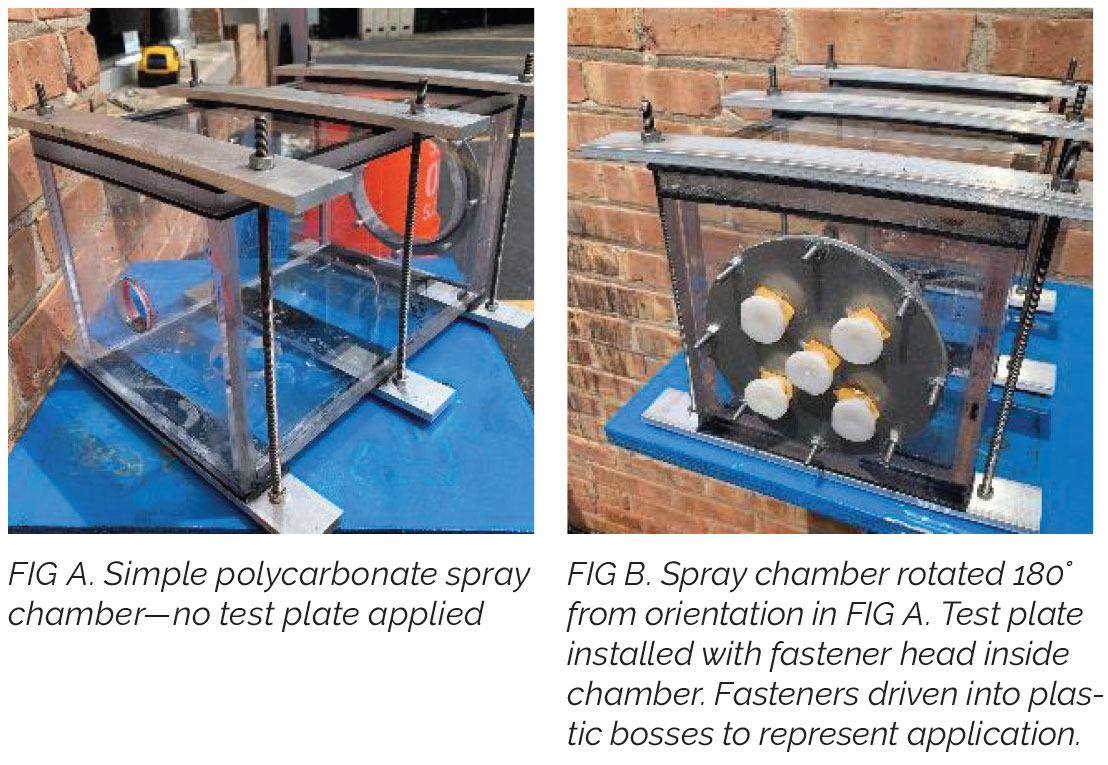Pre-Applied Under Head Sealant Testing
Automotive: Best Tests for Determining Under Head Fastener Sealant Effectiveness
INTRODUCTION
There are a lot of fastener sealing issues that exist today, especially when trying to seal under the head (bearing surface) of a fastener. In addition, there doesn’t seem to be a comprehensive, automotive specification to cover all aspects of under head sealing applications. This paper covers a comprehensive set of tests to thoroughly evaluate under head sealants.
Pressurized Vessel Air Leak Testing
One of the most basic tests used to evaluate the effectiveness of an under head sealant, is a pressurized test vessel that can be placed under water to look for air bubble leaks. Attached to this vessel, is a plate with fasteners/sealants assembled. One example of such a test vessel is demonstrated below.

The beauty of this configuration is that the test plate, with fasteners installed, can be removed and subjected to environmental conditions i.e. freezing/heat cycles, humidity chambers, etc. After conditioning, the joints can be reevaluated for sealing by reattaching the test plate and repressurizing the chamber.

Some customers ask for IP67 or water ingress testing, which is common for electronic devices like cell phones. The device is submerged in a column of water 1 meter deep for a period of time, and evaluated in a number of ways for leakage (pressure decay, observed internal water, etc.). Although this test might have benefits for certain electronic devices, and tests the device from the outside/in, the pressures exerted for a 1 meter column of water are only about 1.4 psi. Significantly higher pressures using the IP67 test method are impractical since the column height of water becomes unmanageable. The benefit of using a submerged, pressurized vessel, is that it is simple to increase the pressure of the vessel using pressure Some customers ask for IP67 or water ingress testing, which is common for electronic devices like cell phones. The device is submerged in a column of water 1 meter deep for a period of time, and evaluated in a number of ways for leakage (pressure decay, observed internal water, etc.). Although this test might have benefits for certain electronic devices, and tests the device from the outside/in, the pressures exerted for a 1 meter column of water are only about 1.4 psi. Significantly higher pressures using the IP67 test method are impractical since the column height of water becomes unmanageable. The benefit of using a submerged, pressurized vessel, is that it is simple to increase the pressure of the vessel using pressure regulators and compressed air. For under head fastener sealants, like Nylok’s NySeal® 2.0, testing starts out at 1 psi, and then a second set of tests are run at 10 psi. As applications warrant, pressure of the vessel is maximized out at plant line pressures (60–80 psi). This test apparatus is typical for performing leak testing per GMW14906 and FCA (Stellantis) PF.90078 specifications (taillight leak testing).
High Pressure Spray Test
If you are involved with fastener engineering for body in white and/or subsequent part attachments, you need to consider potential leak paths and make certain that joints are sealed. The inner compartment must not be compromised with water ingress. One way to simulate water spray from breaching through a fastened joint is a high pressure spray test. Such a test can be designed to simulate very high pressures, such as those found at car wash facilities. A good under head sealant should not allow any water to pass; it should uphold the boundary protection, just as if there were no fastener extending through the body panel.
Nylok has simplified the GM pressure test standard (GMW16001) which is very complex.
The test features an acrylic box, reinforced with aluminum bars. It has openings on opposite ends to a) attach a test panel, and b) to allow for the insertion of a spray wand (power washer wand). Photos of the test apparatus is shown below:

For the high pressure test, a special nozzle is used, and pressures of 1,100 psi are generated, with water flow rates reaching 14 liters/min. After a 3 minute duration, the color change paper on the back side of the fastened joint is evaluated. Even small drops that pass through the joint cause the paper to change from yellow to bright red, indicating a failure. Note that in this photo, the back of the joint has plastic bosses instead of nuts, since this particular application has an M6 fastener being driven into an injection molded, plastic part.

Pressurized, Heated, Fluid Exposure Testing
One of the more aggressive tests for under head sealants is taken from Ford’s WSS-M21P27 standard. In this standard, the test method allows for testing the sealant simultaneously in the following environments: pressure, temperature, and chemical exposure. In this test, a steel block with drilled and tapped holes is used. Hollow channel reservoirs are drilled behind the tapped holes; these are the channels that contain whatever exposure fluid is being tested i.e. motor oil, transmission fluid, etc. Attached to the steel block is a connection to an air line, to facilitate pressurization of the assembly (see test fixture below). The block and fasteners are positioned inside an oven, so that test temperatures can be attained. After introduction of the test fluid and pressurization of the system, leaks are made obvious by introduction of a slight amount of fluorescent tracer that is visible under black light (see photo). This testing answers a number of questions related to more complicated applications, that the previously mentioned tests do not.

Conclusion
So, what is the best way to determine if an under head sealant is reliable in protecting the joint from fluid ingress? Asked another way, are there enough current automotive specifications that cover the gambit for testing joints with under head sealants? The answer seems to suggest that existing automotive specifications can be pieced together to cover the testing, with only a few modifications needed. By combining the best tests from FCA ( Stellantis ) and GMW standards (FCA PF.90078 and GMW14906), a very comprehensive series of tests can be performed to see how the under head sealant performs in a pressurized leak test. One modification to this test also allows for testing the vessel in a vacuum chamber. Since a removable test plate is configured into the test, the fastener joints can be easily exposed to thermal cycles and freezing temperatures, and then retested for sealing capabilities. This can be compared to IP67 testing if the goal is to test electronics packaging underwater. For under body splash testing, a modified version of a GMW specification is proposed (GMW16001), which uses head height, and low/high pressure wash tests to verify that water does not penetrate the joint in these conditions. And finally, a Ford specification (WSS-M21P27) appears to sufficiently cover situations where pressure, temperature, and fluid exposure converge in an application. The challenge is that all of these pieces, representing a comprehensive under head sealant test, lie in multiple places, across several OEM’s. Perhaps these automakers could come together under a neutral organization such as SAE or USCAR, in order to (at last) create a valid and comprehensive series of tests to thoroughly evaluate the performance of under head sealants.
